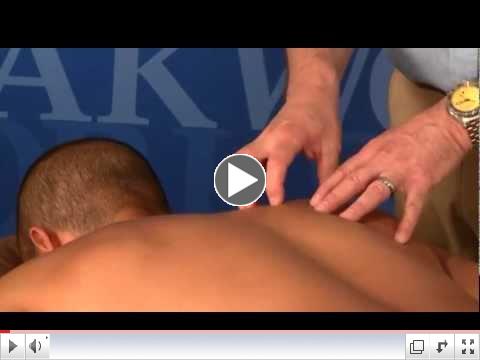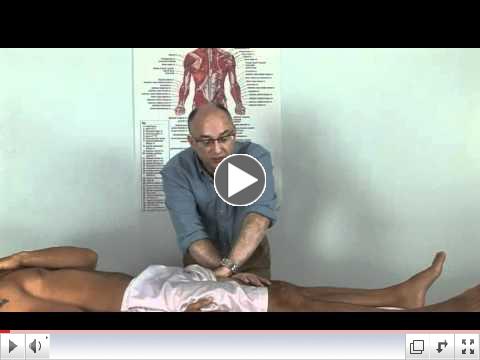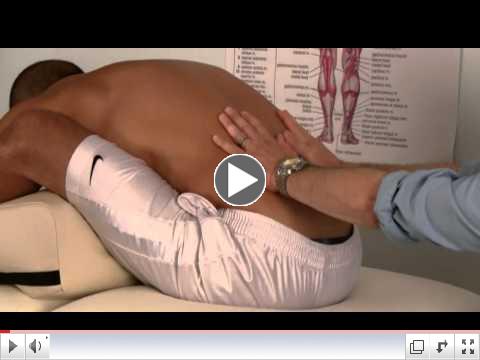 Walt Fritz, PT
Walt has been a Myofascial Release practitioner since 1992 and has been teaching since 1995. His Foundations in Myofascial Release Seminars are presented in small group settings with highly individualized one-on-one attention. Join him for a "New Perspective" on Myofascial Release.
|
 | | Leveling the Landscape of the Thorax |
 | | Myomobilization with Myofascial Release for the Thigh |
 | | Compressive Myofascial Release for the Foot |
 | | Lumbar Lift |
|
|
|
 |
What's New?
Here is my most recent blog post:
A few things about me: I have one foot that points out a bit. I walk like half a duck. Nothing big, I'm probably the only one who notices this, but it's there. If you stood me up for a postural examination, I would be in pretty much the same place as 99% of the therapists who take my Foundations Seminars; I'm crooked! But, so are about 99% of the people out there in the world. Some look like ducks, some like pigeons, some like Quasimodo, others like who-knows-what! Look around you, how many people look like that chart hanging on the wall at school, showing "perfect posture? It will be a small number that fits this "norm" of perfect posture. Do a bit of man/woman-on-the-street interviewing. Are those people who have imperfect posture suffering from pain? A certain percentage will have pain, but most will not. So why do we apply different standards to those who walk into our clinic/practice?
Physical Therapy 101 taught me to look at posture as a means of determining asymmetry. Asymmetry leads to pain. MFR 101 taught the same thing. Both are quite incorrect. I have said many times in this blog that, in the past, I treated with the mindset of returning the body to a more perfect postural alignment will bring about diminished pain, but now I realize that much more is happening than just a change in alignment. If the imperfect posture as a cause of pain logic was true, everyone with less than perfect posture would have pain. We all know that this is not true.
The lesson? Stop looking for ducks. Posture is a very small part of a much deeper assessment that therapists must perform. Think of all of the things we are accomplishing every time we touch and interact with someone. It is a rich, deep body that we impact when we treat. Postural correction, if that is a patient's true goal, is fine. But, please consider letting posture play a more minor role. Quack.
Please check out my other blog entries listed below.
Private and Individualized Seminars by Foundations in Myofascial Release
A recent trend for many health related facilities is to bring in quality continuing education for their therapists. I have done a number of these over the past few years for a wide variety of agencies, including hospitals, home health care agencies, and private clinics. Myofascial release is a highly adaptable modality that is well suited to a wide variety of conditions and disorders. If you have an interest in bringing this sort of training to your facility, simply drop us an email or call at 585-244-6180.
New Locations for Foundations in Myofascial Release Seminars
We have added a few more locations to round out the 2013 schedule, including a special seminar for speech-language pathologists in Chicago, IL; Lafayette, IN; Syracuse, NY; Dallas, TX, and a special Foundations I Seminar to be held this May in Rochester, New York. Check out the entire schedule below.
For Now,
Walt Fritz, PT
|
|
If you enjoy the MFRmail Newsletter, please forward to a friend.
It makes no sense to keep this to yourself... | |
 |
Check out the Visible Body App for the iPad and other devices. One of my favorite anatomy guides and it is fully interactive. Just click the Visible Body symbol above to read all about it.
|

Upcoming Seminars
Myofascial Release...Demystified
Foundations in Myofascial Release Seminars has been chosen to present at the 2013 World Massage Conference (August 4-7, 2013 in Long Beach, CA). Join us aboard the Queen Mary!
Foundations I
Ottawa, Illinois
March 22-24, 2013 Sponsored by: Two Rivers Bodyshop Rochester, NY
May 4-6 Special pricing for this private class, please email for details. Philadelphia (Chadds Ford), PA
May 17-19, 2013 Sponsored by: Institute for Therapeutic Massage and Bodywork, Inc.Boston, Massachusetts June 14-16, 2013 Sponsored by: Cortiva Institute, Boston CampusDallas (Flower Mound), Texas
July 12-14, 2013 Sponsored by: Institute of Bodywork StudiesLong Beach, California
(World Massage Festival 2013)
August 5-7, 2013 Syracuse, New York
September 13-15, 2013 Sponsored by: The Onondaga School of Therapeutic Massage/Syracuse CampusCharlotte (Cornelius), North Carolina
September 27-29, 2013 Sponsored by: NC Massage School Foundations II(NO prerequisite required)
Las Cruces, New Mexico (Early Bird Discount ends 02/01/13)
February 22-24, 2013 Sponsored by: Relax! Massage Therapy Inc.Canton, Ohio
October 25-27, 2012 Sponsored by: Stark State CollegeEnglewood, Florida
April 12-14, 2013 Sponsored by: The Open StudioLafayette, Indiana
August 23-25, 2013 St. Simons Island, GeorgiaOctober 11-13, 2013 Sponsored by: A Balancing Act Listening With Your Hands Myofascial Release for Speech-Language Pathologists A special class that I will be co-teaching with Benjamin Asher, MD. Chicago, Illinois April 27-28, 2013 All Foundation in Myofascial Release Seminars are 20 contact hours/over two and one-half days and it are packed with techniques, theory, and practical application. Building upon a deep model of evaluation, you will leave this seminar ready to use Myofascial Release on your first day back to work. Developing the "Feel" for soft tissue restriction and connecting this to your patient's pain is an essential element missing in other lines of MFR education. Foundations Seminars delves into learning the "Feel", making you a more effective therapist. NCBTMB CE hours continuing education credits are approved. Physical Therapy CE Hours are available in many circumstances, as well as CE Hours for other professions available; please inquire. For full details and to register, please refer to the Seminars Page of the website. You have many options when it comes to continuing education training. Myofascial Release is a powerful modality for eliminating pain and restoring function, but how do you choose? Foundations Seminars draw strongly Walt Fritz's background as a physical therapist, as well as a Myofascial Release practitioner. He has been a New York State Licensed Physical Therapist since 1985 and has been practicing Myofascial Release since 1992. He spent 10 years teaching nationally with other well-regarded practitioners and started his own seminars in 2005. Foundations in Myofascial Release Seminars delve deeply into the evaluation of soft tissue dysfunction from both a more traditional fascia perspective as well as looking at pain through the lens of neuroscience. Through deep evaluation you will explore postural and movement pattern disorders. Treatment then proceeds in a logical manner. It is important to know your strengths as both a therapist and teacher. Walt's strengths lie in his ability to effectively connect his students with the "Feel" of soft tissue restriction and its elimination. Using a gentle approach, he eliminates the need for aggressive work, which is hard on both the patient as well as the therapist. He has taken the work he was taught and moved in a direction of logic and simplicity, without the heavy trappings of New Age teachings. Learning is an ongoing process for all of us, and Foundations Seminars follows this trend. We review all relevant explanations for pain and dysfunction, from the more traditional models of "fascial restriction" to newer models based on scientifically accepted pain theory. Neuromodulatory treatment is introduced along side myofascial release. The overlap is at times quite amazing! All Foundations Seminars attend to the individual needs and background of all participants. The intended audience includes massage therapists, physical therapists, occupational therapists, speech and language pathologists, nurses, chiropractors, and physicians. Instruction is in a very approachable and interactive style. Small class size guarantees individualized one on one attention. The incorporation of a deep model of evaluative understanding regarding the nature of dysfunction within the body aids in connecting the theory of Myofascial Release to the application of treatment. You will leave Foundations I Seminar prepared to use Myofascial Release from your first day back at work. Walt makes himself available for follow up consultation as needed, so you never feel alone in this process. Foundations Seminars are packed with technique, theory, and evaluation. There is considerable lab time where you will get plenty of one-on-one instruction, assuring you to have a positive learning experience. Foundations in Myofascial Release Seminars provide explanations for the workings of myofascial release from both the bio mechanical model, as well as introducing neurobiological explanations. Foundations in Myofascial Release Seminars emphasize a solid orthopedic basis for evaluation and treatment, small group trainings, and a high degree of one-on-one interaction; does this sound like what you are seeking? Myofascial Release...Demystified. I have found myofascial release to be the most effective method for both finding the causes of pain, as well as eliminating them. My goal is to pass this along to you. Walt Fritz, PT | |
The Foundations in Myofascial Release Seminar Approach...
in a Nutshell, Part Two.
I shared my introductory thoughts on the new approach and direction that Foundations Seminars have taken in the December edition of this newsletter. If you would like to read this again, please click here. I've had the chance to share information this with a good number of therapists over the past few months at various seminars around the country and the reception has been very good. New tools are great, but new mindsets are even better. This month I wish to take you a bit farther on this journey. Please note; myofascial release need not be a difficult modality to learn, nor does changing your mindset in order to accept other theories of explanation. So what is happening in the photo shown above? This is a treatment that I use quite regularly with my clientele who suffer with shoulder region pain and related issues. It is quite different to the form of MFR that I was taught, but I have discovered that there are more than one "true form" of myofascial release. This stretch utilizes Dycem, a great therapy product modified for use in this setting. The Dycem concept comes from Diane Jacobs, PT, a talented colleague who taught me the principles of this work in her DermoNeuroModulation Seminar. She posits that simply by stretching the skin, we influence the superficial mechanoreceptors, which in turn influence levels of tone, etc. in the body. In many ways I feel that I am covering a lot of potential bases while treating in this manner. Theories abound in our work and arguments are even more common when it comes to firmly believing what we are affecting when we treat. "Fascially", I would have said that we were taking the tightness under tension and causing it to release. The term "release" has fallen out of favor with many in the science-based community, who state that fascia lacks the potential to change in the manner it has been described for the past few decades. "Magical Thinking" is another way this model has been described. Magical or not, skin-based or not, lightly treating from a perspective as shown above has profound effect on pain, perceived tightness, and dysfunction. The concept might seem too simple to be effective. Don't take my word for it, try it yourself. While Dycem is not necessary, it does provide a marked increase in grip and sensitivity. Liquid Chalk works fine as well. Gently place your hand on the shoulder (or whatever part of the body is involved) and gently stretch the skin in any direction. You are interacting with your client, not dictating action. Note the tissue quality under your hand; can you feel general flexibility, or are there areas that feel bound down or snagged? Moving the skin in a certain direction may decrease or eliminate the pain. This is a direction to hold the skin stretch. You may also find a direction that brings your client's awareness to the pain, while not actually increasing the feeling. This is another direction to hold the stretch. Stretch times are much like traditional MFR hold times, 3-5 minutes or more. You are waiting until you sense a change, which may be a softening, warmth, or a change in the perception of pain. Treatment easily blends with self-treatment education. Simple, right? Can you create an entire treatment paradigm based on this information? Yes, especially if you educate yourself on how the body actually works. Is this myofascial release the way I learned it? Certainly not, this is the new myofascial release.
|
|
|
Sponsoring a Foundations in Myofascial Release Seminar
Foundations Seminars are dedicated to providing quality small group setting continuing education workshops. Using a sponsorship model has brought seminars to smaller cities that are typically skipped by the larger companies. If you have an interest in bringing a Foundations Seminar to your town, I would love to talk. Seminar sponsoring brings attention to your practice and allows you to build a reputation in your community. Also, you will share a percentage of the registration fees and attend the seminar for free. If you would like more information, refer to this page of the website, then email me or call at 585-244-6180. | |
|